A Novel Reverse Combination Configuration to Reduce Mismatch Loss for Stratospheric Airship Photovoltaic Arrays
Abstract
1. Introduction
2. Modeling
2.1. Solar Radiation Model
2.2. Solar Radiation Model
2.3. PV Array Output Power Model
2.4. The Diode Equivalent Model of a Solar Cell
3. Methodology
3.1. TCT Configuration
3.2. Irradiance Distribution Characteristic of PV Array
3.3. Static Reconfiguration
3.4. Airship PV Array Reconfiguration Technique Using Reverse Combination Method
4. Simulation Results and Discussion
4.1. Analysis of the Performance of the Reverse Combination (RC) Configuration
4.1.1. Characteristic Curves
4.1.2. Mismatch Loss Power
4.1.3. Fill Factor (FF)
4.2. Simulation of Flight Cruising in a Real Wind Field
4.2.1. Flight Condition
4.2.2. Comparison of Energy Generation
5. Conclusions
- (1)
- The irradiance of the PV array exhibits a radial and circumferential gradient along the stratospheric airship. This gradient distribution varies systematically with the pitch and yaw angles. The non-uniformity in the irradiance distribution across the array leads to mismatch losses and significantly impacts the power output of the PV array.
- (2)
- The RC configuration optimizes the distribution of irradiance by combining adjacent column components in reverse order. This approach reduces the differences in irradiance among the row components of the array, thereby decreasing mismatch losses. Simulation results demonstrate that the RC configuration significantly enhances the output power of the PV array and eliminates localized MPP on the P-V curve.
- (3)
- The performance of the RC configuration surpasses that of the SP, HTCT, and VTCT configurations. It achieves the highest output power during the entire day’s operation. The net energy accumulated on the four days is 10.6% higher than the suboptimal HTCT configuration. Implementing this configuration can alleviate to some extent the energy shortage issue during weak irradiance flight conditions.
Author Contributions
Funding
Institutional Review Board Statement
Informed Consent Statement
Data Availability Statement
Conflicts of Interest
Nomenclature
| air mass ratio | |
| unit solar cell area, m2 | |
| specific heat capacity of PV module, J/(kg·K) | |
| day number in a year | |
| D | the airship’s maximum diameter, m |
| orbital eccentricity of Earth | |
| time correction term | |
| natural convective heat transfer coefficient | |
| forced convective heat transfer coefficient | |
| saturation current, A | |
| direct radiation intensity, W/m2 | |
| scattered radiation intensity, W/m2 | |
| output current of PV module, A | |
| maximum power point current, A | |
| photoelectric current of PV module, A | |
| short-circuit current under standard irradiance, A | |
| short circuit current, A | |
| atmosphere thermal conductivity | |
| m | number of cell units in the circumferential direction |
| n | number of cell units in the axial direction |
| unit normal vector of PV module | |
| correction term of day number | |
| unit vector of solar direct radiation | |
| free convection Nusselt number | |
| atmospheric pressure and sea level, Pa | |
| atmospheric pressure at the cruising altitude, Pa | |
| mismatch loss power, kW | |
| output power of PV module, W | |
| electric charge, C | |
| convective heat transfer energy, J | |
| total irradiance power of PV module, W | |
| infrared radiation energy, J | |
| transformation from the airship coordinate system to the inertial coordinate system | |
| radius of Earth | |
| Reynolds number | |
| series resistance of PV module | |
| parallel resistance of PV module | |
| atmospheric temperature, K | |
| reference temperature, K | |
| operating temperature of PV module, K | |
| maximum power point voltage, V | |
| voltage of PV array, V | |
| open circuit voltage, V | |
| x | x coordinate in airship body reference system, m |
| y | y coordinate in airship body reference system, m |
| z | z coordinate in airship body reference system, m |
| angle between PV module and horizontal plane | |
| external emissivity of infrared radiation | |
| azimuth angle | |
| solar day angle | |
| solar declination angle | |
| angle of view | |
| solar elevation angle | |
| solar hour angle | |
| yaw angle | |
| pitch angle | |
| roll angle | |
| local latitude | |
| atmospheric transmissivity | |
| true anomaly | |
| power temperature coefficient of PV module | |
| areal density PV module, kg/m2 | |
| Stefan–Boltzmann constant, J/K | |
| Abbreviation | |
| BL | bridge-link |
| FF | fill factor |
| HC | honey-comb |
| HTCT | horizontal total-cross-tied |
| KCL | Kirchhoff’s current law |
| SP | series–parallel |
| TCT | total-cross-tied |
| VTCT | vertical total-cross-tied |
References
- Schmidt, D.K.; Stevens, J.; Roney, J. Near-space station-keeping performance of a large high-altitude notional airship. J. Aircr. 2007, 44, 611–615. [Google Scholar] [CrossRef]
- Manikandan, M.; Pant, R.S. Research and advancements in hybrid airships—A review. Prog. Aerosp. Sci. 2021, 127, 100741. [Google Scholar]
- Zhang, J.; Xuan, Y.; Yang, L. A novel choice for the photovoltaic–thermoelectric hybrid system: The perovskite solar cell. Int. J. Energy Res. 2016, 40, 1400–1409. [Google Scholar] [CrossRef]
- Zhang, L.C.; Lv, M.Y.; Zhu, W.Y.; Du, H.F.; Meng, J.H.; Li, J. Mission-based multidisciplinary optimization of solar-powered hybrid airship. Energy Convers. Manag. 2019, 185, 44–54. [Google Scholar] [CrossRef]
- Pande, D.; Verstraete, D. Impact of solar cell characteristics and operating conditions on the sizing of a solar powered nonrigid airship. Aerosp. Sci. Technol. 2018, 72, 353–363. [Google Scholar] [CrossRef]
- Li, J.; Lv, M.; Tan, D.; Zhu, W.; Sun, K.; Zhang, Y. Output performance analyses of solar array on stratospheric airship with thermal effect. Appl. Therm. Eng. 2016, 104, 743–750. [Google Scholar] [CrossRef]
- Du, H.F.; Zhu, W.Y.; Wu, Y.F.; Zhang, L.C.; Li, J.; Lv, M.Y. Effect of angular losses on the output performance of solar array on long-endurance stratospheric airship. Energy Convers. Manag. 2017, 147, 135–144. [Google Scholar] [CrossRef]
- Durisch, W.; Bitnar, B.; Mayor, J.C.; Kiess, H.; Lam, K.H.; Close, J. Efficiency model for photovoltaic modules and demonstration of its application to energy yield estimation. Sol. Energy Mater. Sol. Cells 2007, 91, 79–84. [Google Scholar] [CrossRef]
- Yang, X.X.; Liu, D.N. Renewable power system simulation and endurance analysis for stratospheric airships. Renew. Energy 2017, 113, 1070–1076. [Google Scholar] [CrossRef]
- Gonzalo, J.; López, D.; Domínguez, D.; García, A.; Escapa, A. On the capabilities and limitations of high altitude pseudo-satellites. Prog. Aerosp. Sci. 2018, 98, 37–56. [Google Scholar] [CrossRef]
- Wang, Q.; Chen, J.; Fu, G.; Duan, D.; Zhao, H. A methodology for optimisation design and analysis of stratosphere airship. Aeronaut. J. 2009, 113, 533–540. [Google Scholar] [CrossRef]
- Zhang, L.C.; Lv, M.Y.; Meng, J.H.; Du, H.F. Optimization of solar-powered hybrid airship conceptual design. Aerosp. Sci. Technol. 2017, 65, 54–61. [Google Scholar] [CrossRef]
- Meng, J.H.; Liu, S.Y.; Yao, Z.B.; Lv, M.Y. Optimization design of a thermal protection structure for the solar array of stratospheric airships. Renew. Energy 2019, 133, 593–605. [Google Scholar] [CrossRef]
- Lv, M.; Li, J.; Du, H.; Zhu, W.; Meng, J. Solar array layout optimization for stratospheric airships using numerical method. Energy Convers. Manag. 2017, 135, 160–169. [Google Scholar] [CrossRef]
- Alam, M.I.; Pant, R.S. Multi-objective multidisciplinary design analyses and optimization of high altitude airships. Aerosp. Sci. Technol. 2018, 78, 248–259. [Google Scholar] [CrossRef]
- Jiang, Y.; Lv, M.; Sun, K. Effects of installation angle on the energy performance for photovoltaic cells during airship cruise flight. Energy 2022, 258, 124982. [Google Scholar] [CrossRef]
- Wang, H.F.; Song, B.F.; Zuo, L.K. Effect of high-altitude airship’s attitude on performance of its energy system. J. Aircr. 2007, 44, 2077–2080. [Google Scholar] [CrossRef]
- Zhu, W.Y.; Li, J.; Xu, Y.M. Optimum attitude planning of near-space solar powered airship. Aerosp. Sci. Technol. 2019, 84, 291–305. [Google Scholar] [CrossRef]
- Zhang, L.C.; Li, J.; Wu, Y.F.; Lv, M.Y. Analysis of attitude planning and energy balance of stratospheric airship. Energy 2019, 183, 1089–1103. [Google Scholar] [CrossRef]
- Shan, C.; Lv, M.Y.; Sun, K.W.; Gao, J. Analysis of energy system configuration and energy balance for stratospheric airship based on position energy storage strategy. Aerosp. Sci. Technol. 2020, 101, 105844. [Google Scholar] [CrossRef]
- Quesada, G.; Guillon, L.; Rousse, D.R.; Mehrtash, M.; Dutil, Y.; Paradis, P.L. Tracking strategy for photovoltaic solar systems in high latitudes. Energy Convers. Manag. 2015, 103, 147–156. [Google Scholar] [CrossRef]
- Hu, Y.G.; Yao, Y.X. A methodology for calculating photovoltaic field output and effect of solar tracking strategy. Energy Convers. Manag. 2016, 126, 278–289. [Google Scholar] [CrossRef]
- Lv, M.; Li, J.; Zhu, W.; Du, H.; Meng, J.; Sun, K. A theoretical study of rotatable renewable energy system for stratospheric airship. Energy Convers. Manag. 2017, 140, 51–61. [Google Scholar] [CrossRef]
- Du, H.F.; Li, J.; Zhu, W.Y.; Yao, Z.B.; Cui, E.Q.; Lv, M.Y. Thermal performance analysis and comparison of stratospheric airships with rotatable and fixed photovoltaic array. Energy Convers. Manag. 2018, 158, 373–386. [Google Scholar] [CrossRef]
- Zhu, W.Y.; Xu, Y.M.; Li, J.; Zhang, L.C. Performance analysis of rotatable energy system of high-altitude airships in real wind field. Aerosp. Sci. Technol. 2020, 98, 105689. [Google Scholar] [CrossRef]
- Liu, Y.; Sun, K.; Xu, Z.; Lv, M. Energy efficiency assessment of photovoltaic array on the stratospheric airship under partial shading conditions. Appl. Energy 2022, 325, 119898. [Google Scholar] [CrossRef]
- Belhachat, F.; Larbes, C. PV array reconfiguration techniques for maximum power optimization under partial shading conditions: A review. Sol. Energy 2021, 230, 558–582. [Google Scholar] [CrossRef]
- Kuznetsov, P.; Yuferev, L.; Voronin, D.; Panchenko, V.A.; Jasinski, M.; Najafi, A.; Leonowicz, Z.; Bolshev, V.; Martirano, L. Methods Improving Energy Efficiency of Photovoltaic Systems Operating under Partial Shading. Appl. Sci. 2021, 11, 696. [Google Scholar] [CrossRef]
- Rani, B.I.; Ilango, G.S.; Nagamani, C. Enhanced Power Generation From PV Array Under Partial Shading Conditions by Shade Dispersion Using Su Do Ku Configuration. IEEE Trans. Sustain. Energy 2013, 4, 594–601. [Google Scholar] [CrossRef]
- Venkateswari, R.; Rajasekar, N. Power enhancement of PV system via physical array reconfiguration based Lo Shu technique. Energy Convers. Manag. 2020, 215, 112885. [Google Scholar] [CrossRef]
- Nasiruddin, I.; Khatoon, S.; Jalil, M.F.; Bansal, R.C. Shade diffusion of partial shaded PV array by using odd-even structure. Sol. Energy 2019, 181, 519–529. [Google Scholar] [CrossRef]
- Madhusudanan, G.; Senthilkumar, S.; Anand, I.; Sanjeevikumar, P. A shade dispersion scheme using Latin square arrangement to enhance power production in solar photovoltaic array under partial shading conditions. J. Renew. Sustain. Energy 2018, 10, 053506. [Google Scholar] [CrossRef]
- Wu, J.T.; Fang, X.D.; Wang, Z.G.; Hou, Z.X.; Ma, Z.Y.; Zhang, H.L.; Dai, Q.M.; Xu, Y. Thermal modeling of stratospheric airships. Prog. Aerosp. Sci. 2015, 75, 26–37. [Google Scholar] [CrossRef]
- Yao, W.; Lu, X.C.; Wang, C.; Ma, R. A heat transient model for the thermal behavior prediction of stratospheric airships. Appl. Therm. Eng. 2014, 70, 380–387. [Google Scholar] [CrossRef]
- El Mghouchi, Y.; Chham, E.; Krikiz, M.S.; Ajzoul, T.; El Bouardi, A. On the prediction of the daily global solar radiation intensity on south-facing plane surfaces inclined at varying angles. Energy Convers. Manag. 2016, 120, 397–411. [Google Scholar] [CrossRef]
- Shan, C.; Sun, K.; Ji, X.; Cheng, D. A reconfiguration method for photovoltaic array of stratospheric airship based on multilevel optimization algorithm. Appl. Energy 2023, 352, 121881. [Google Scholar] [CrossRef]
- Li, J.; Liao, J.; Liao, Y.X.; Du, H.F.; Luo, S.B.; Zhu, W.Y.; Lv, M.Y. An approach for estimating perpetual endurance of the stratospheric solar-powered platform. Aerosp. Sci. Technol. 2018, 79, 118–130. [Google Scholar] [CrossRef]
- Wang, J.; Meng, X.Y.; Li, C.C.; Qiu, W.J. Analysis of long-endurance station-keeping flight scenarios for stratospheric airships in the presence of thermal effects. Adv. Space Res. 2021, 67, 4121–4141. [Google Scholar] [CrossRef]
- Ram, J.P.; Manghani, H.; Pillai, D.S.; Babu, T.S.; Miyatake, M.; Rajasekar, N. Analysis on solar PV emulators: A review. Renew. Sustain. Energy Rev. 2018, 81, 149–160. [Google Scholar] [CrossRef]
- Gupta, J.; Hussain, A.; Singla, M.K.; Nijhawan, P.; Haider, W.; Kotb, H.; AboRas, K.M. Parameter Estimation of Different Photovoltaic Models Using Hybrid Particle Swarm Optimization and Gravitational Search Algorithm. Appl. Sci. 2023, 13, 249. [Google Scholar] [CrossRef]
- Dimara, A.; Papaioannou, A.; Grigoropoulos, K.; Triantafyllidis, D.; Tzitzios, I.; Anagnostopoulos, C.-N.; Krinidis, S.; Ioannidis, D.; Tzovaras, D. A Novel Real-Time PV Error Handling Exploiting Evolutionary-Based Optimization. Appl. Sci. 2023, 13, 12682. [Google Scholar] [CrossRef]
- Velasco, G.; Guinjoan, F.; Pique, R. Grid-Connected PV Systems Energy Extraction Improvement by means of an Electric Array Reconfiguration (EAR) Strategy: Operating Principle and Experimental Results. In Proceedings of the 39th IEEE Power Electronics Specialists Conference (PESC 08), Rhodes Isl, Greece, 15–19 June 2008; pp. 1983–1988. [Google Scholar]
- Dhanalakshmi, B.; Rajasekar, N. A novel Competence Square based PV array reconfiguration technique for solar PV maximum power extraction. Energy Convers. Manag. 2018, 174, 897–912. [Google Scholar] [CrossRef]
- Sarniak, M.T. Modeling the Functioning of the Half-Cells Photovoltaic Module under Partial Shading in the Matlab Package. Appl. Sci. 2020, 10, 2575. [Google Scholar] [CrossRef]
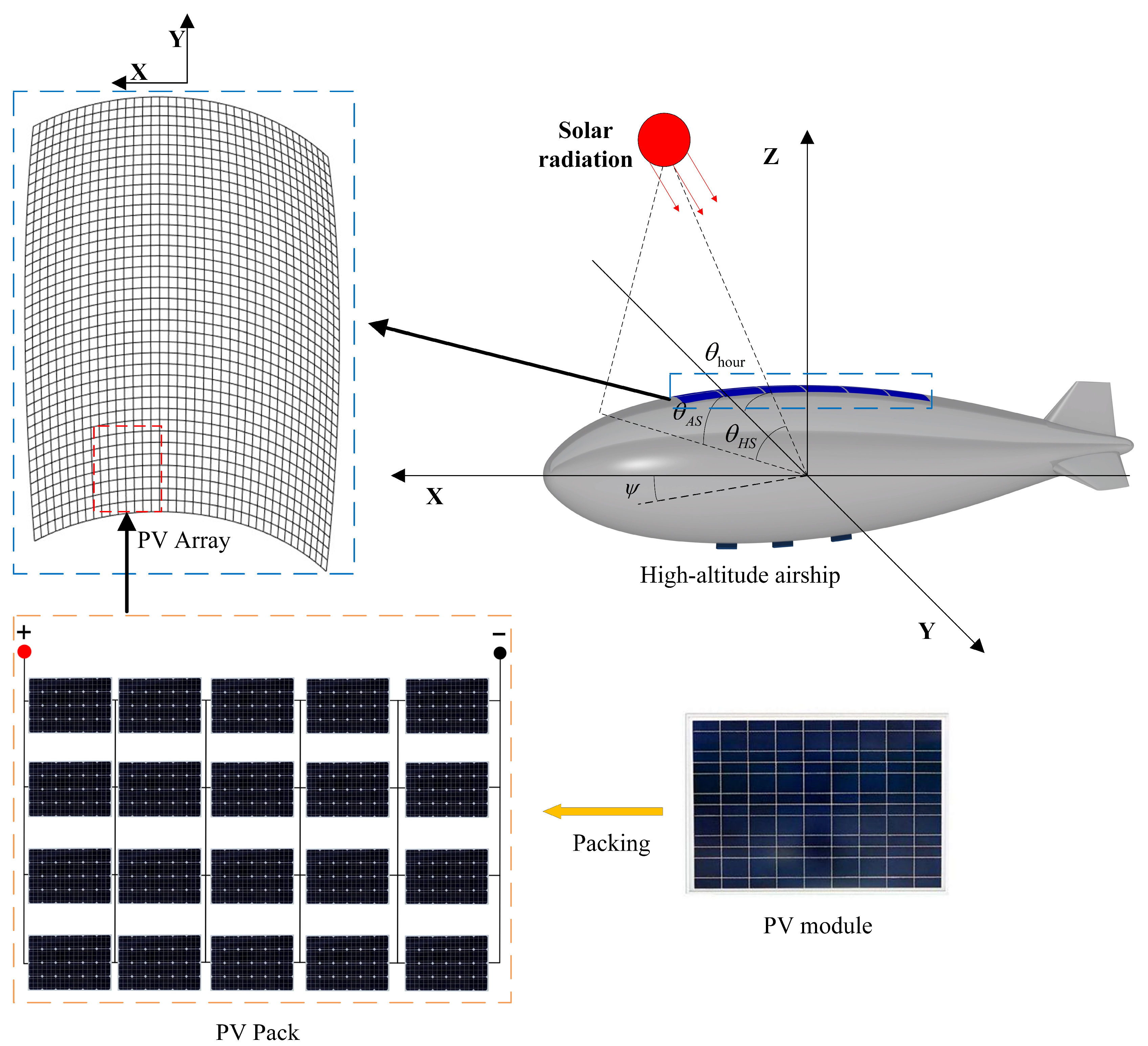
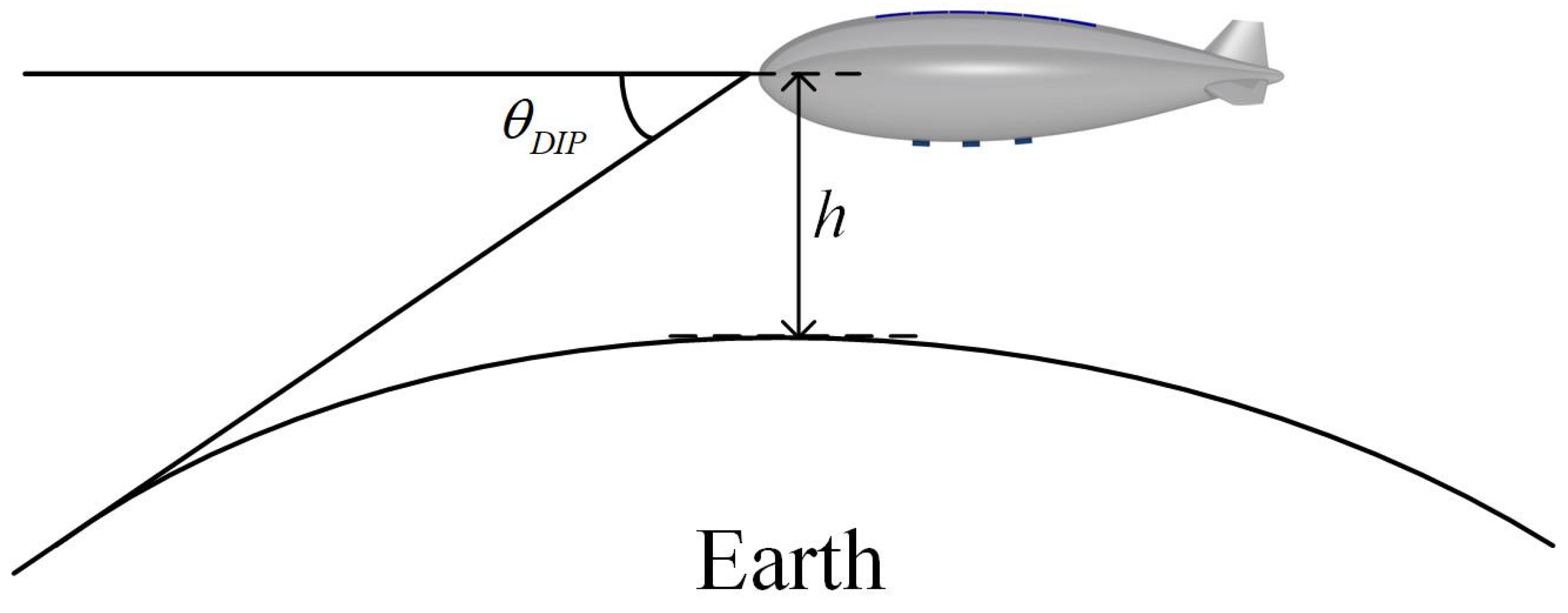

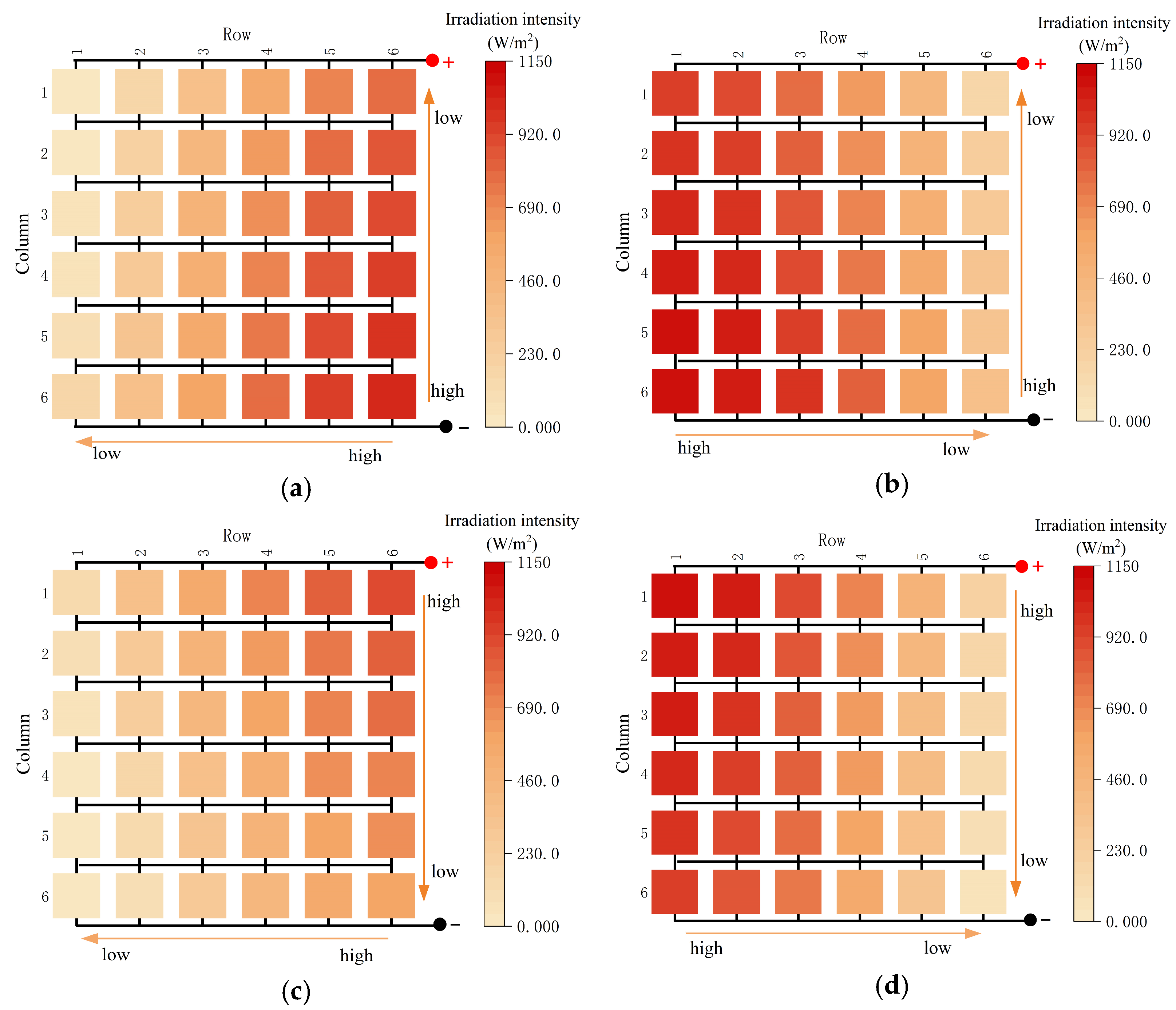
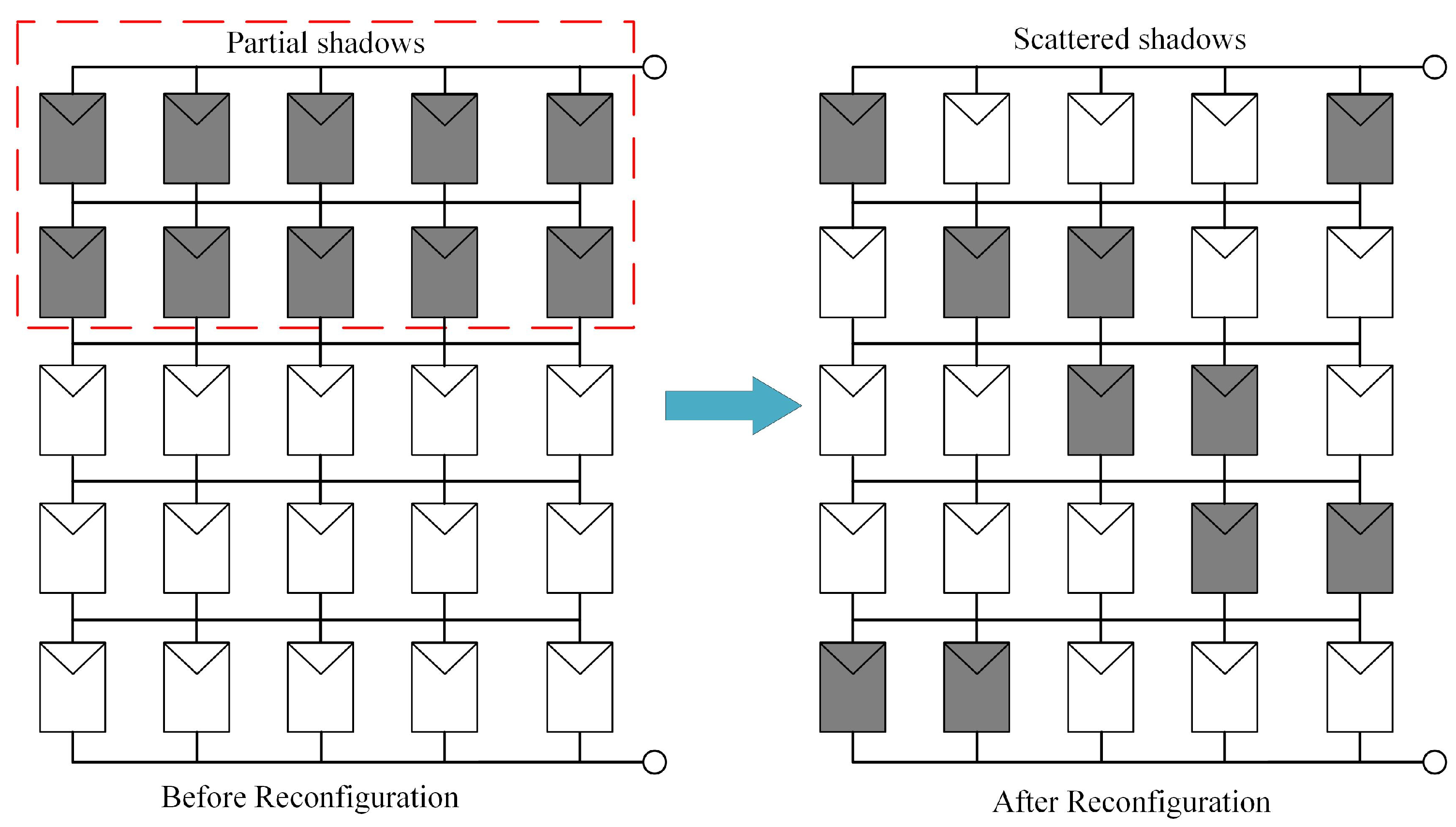
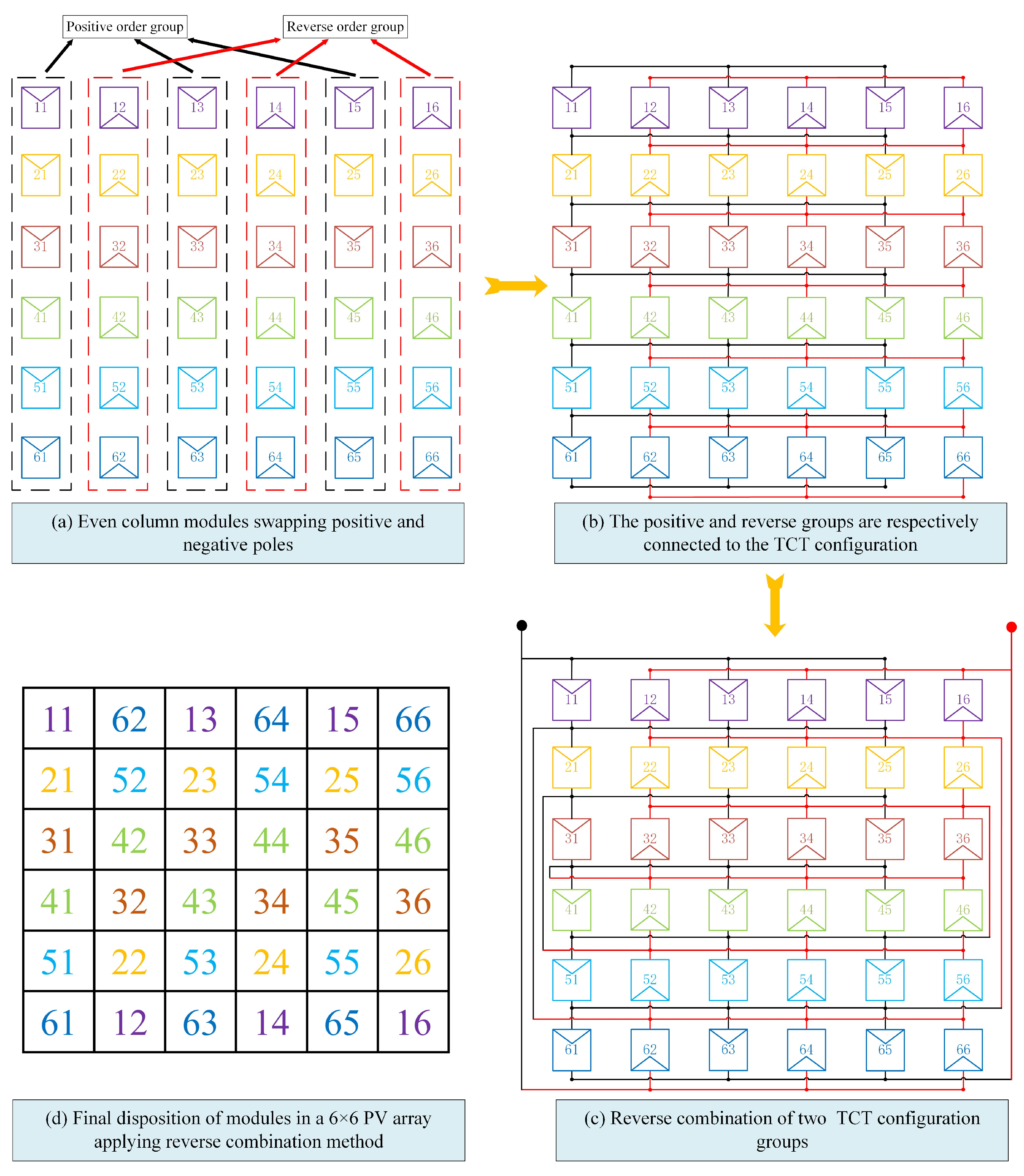
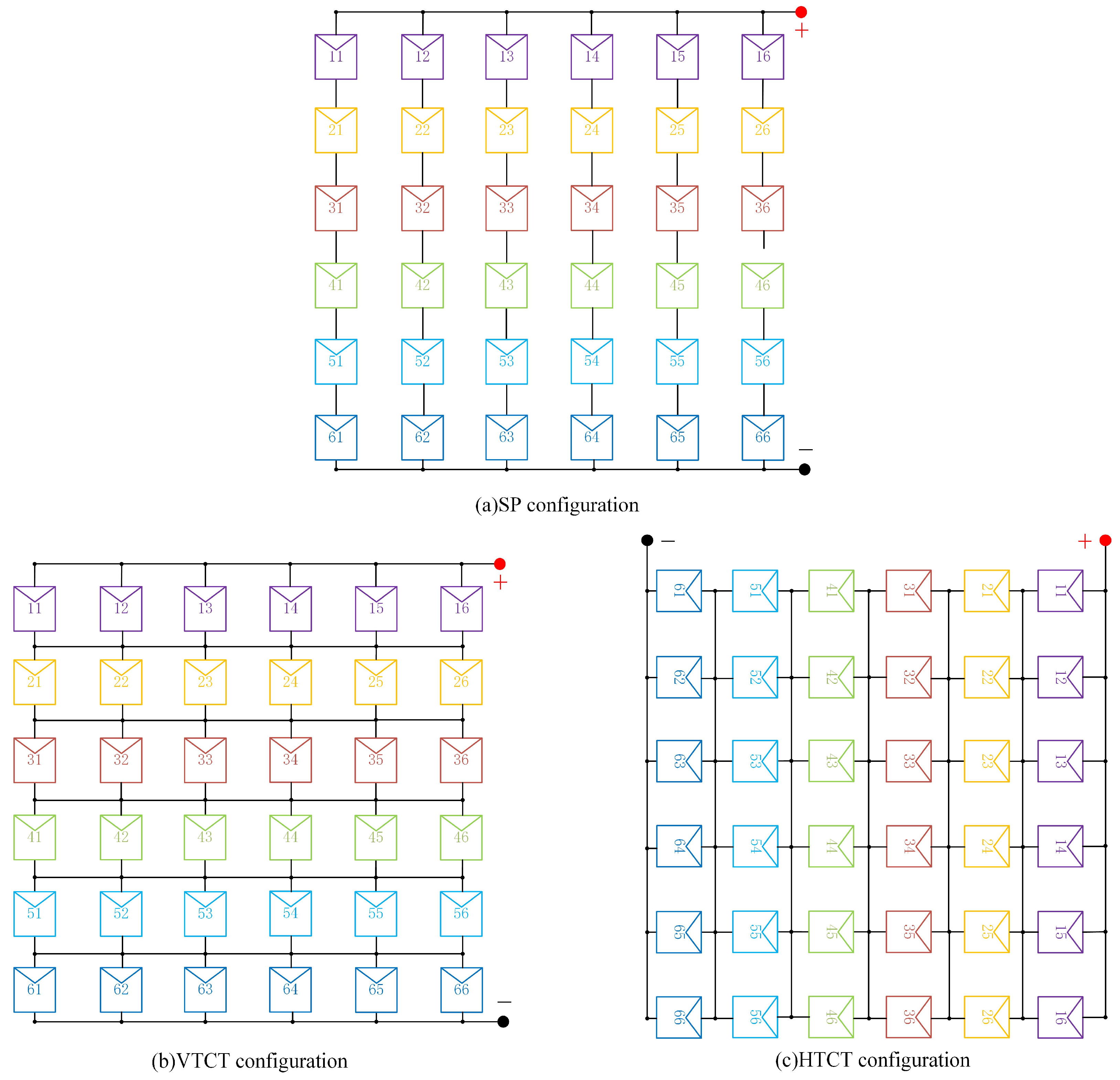


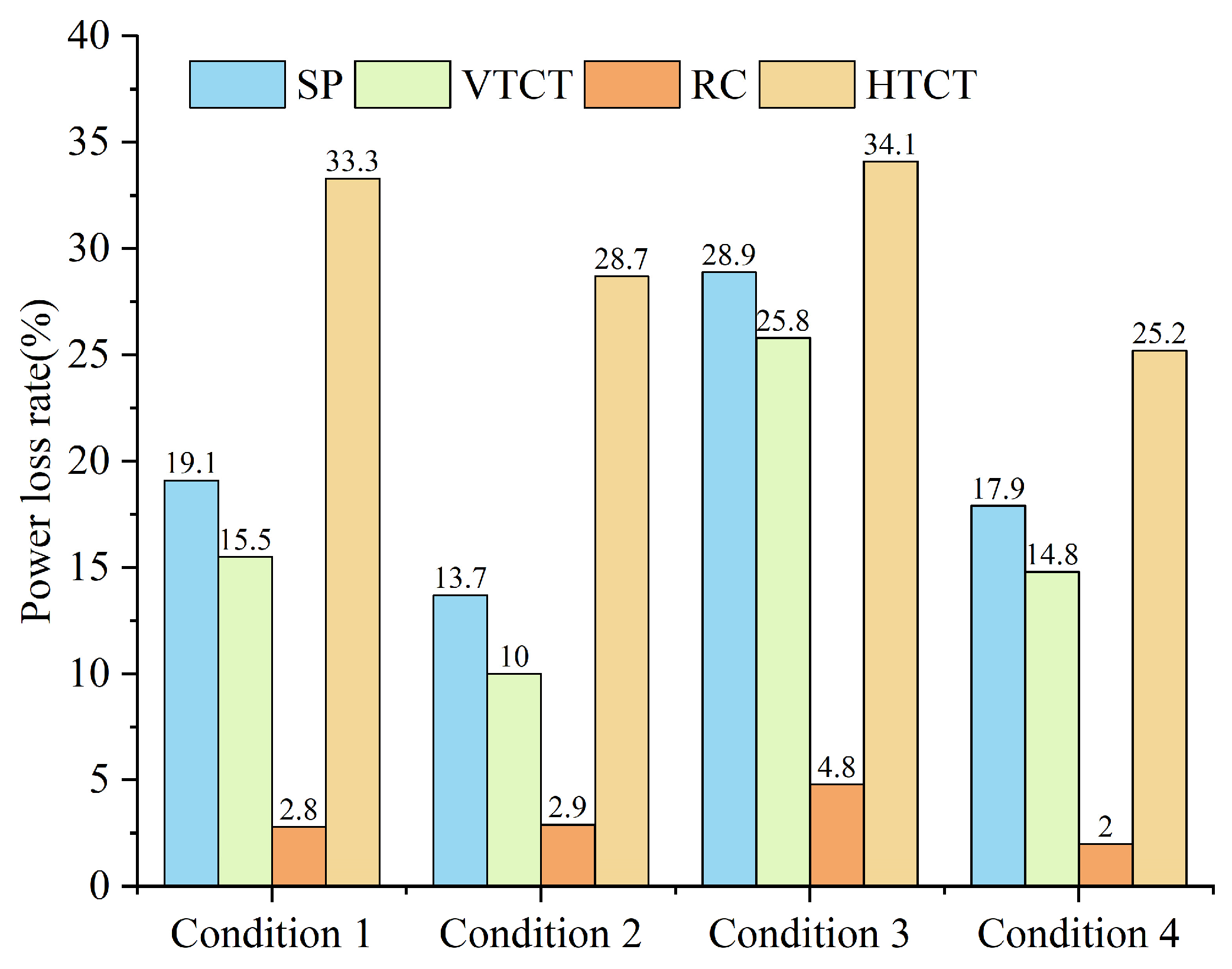

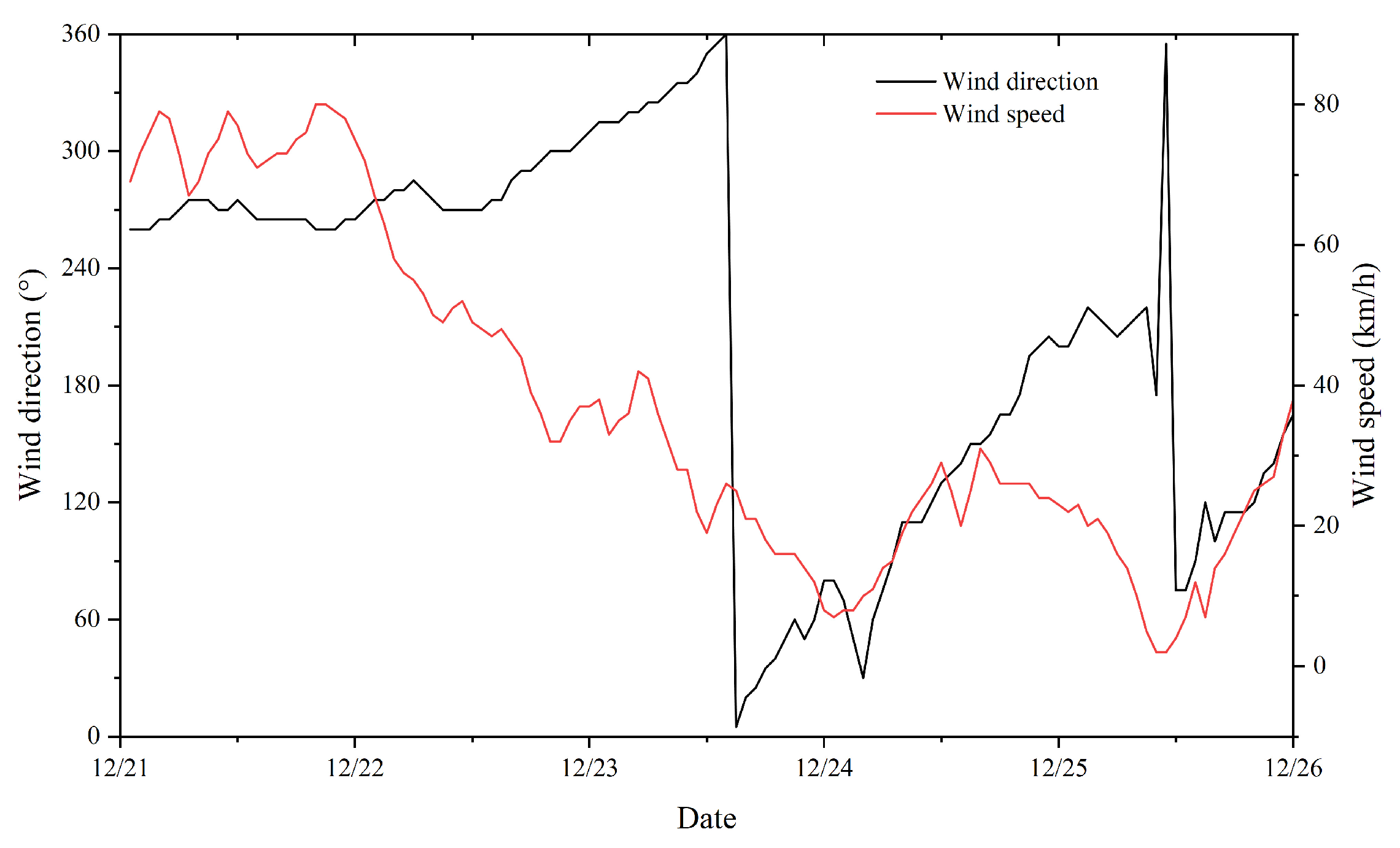
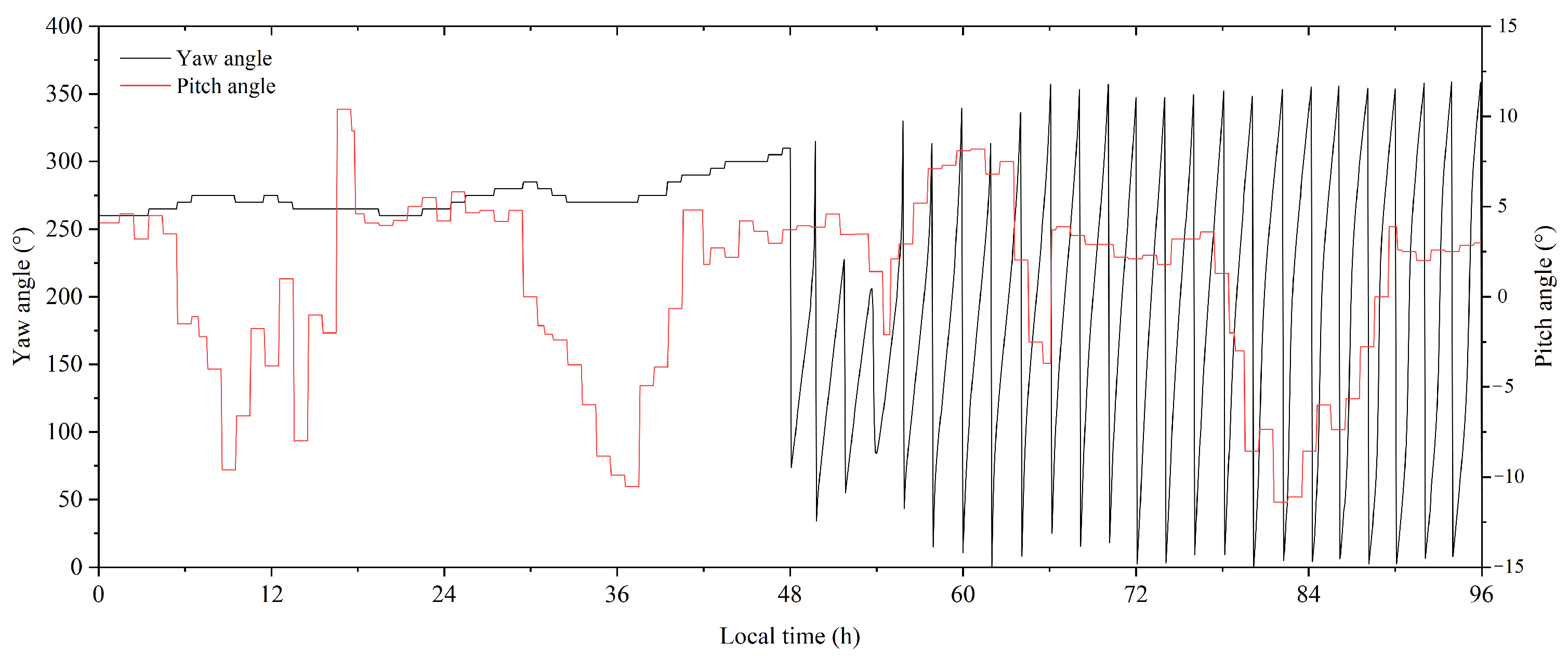
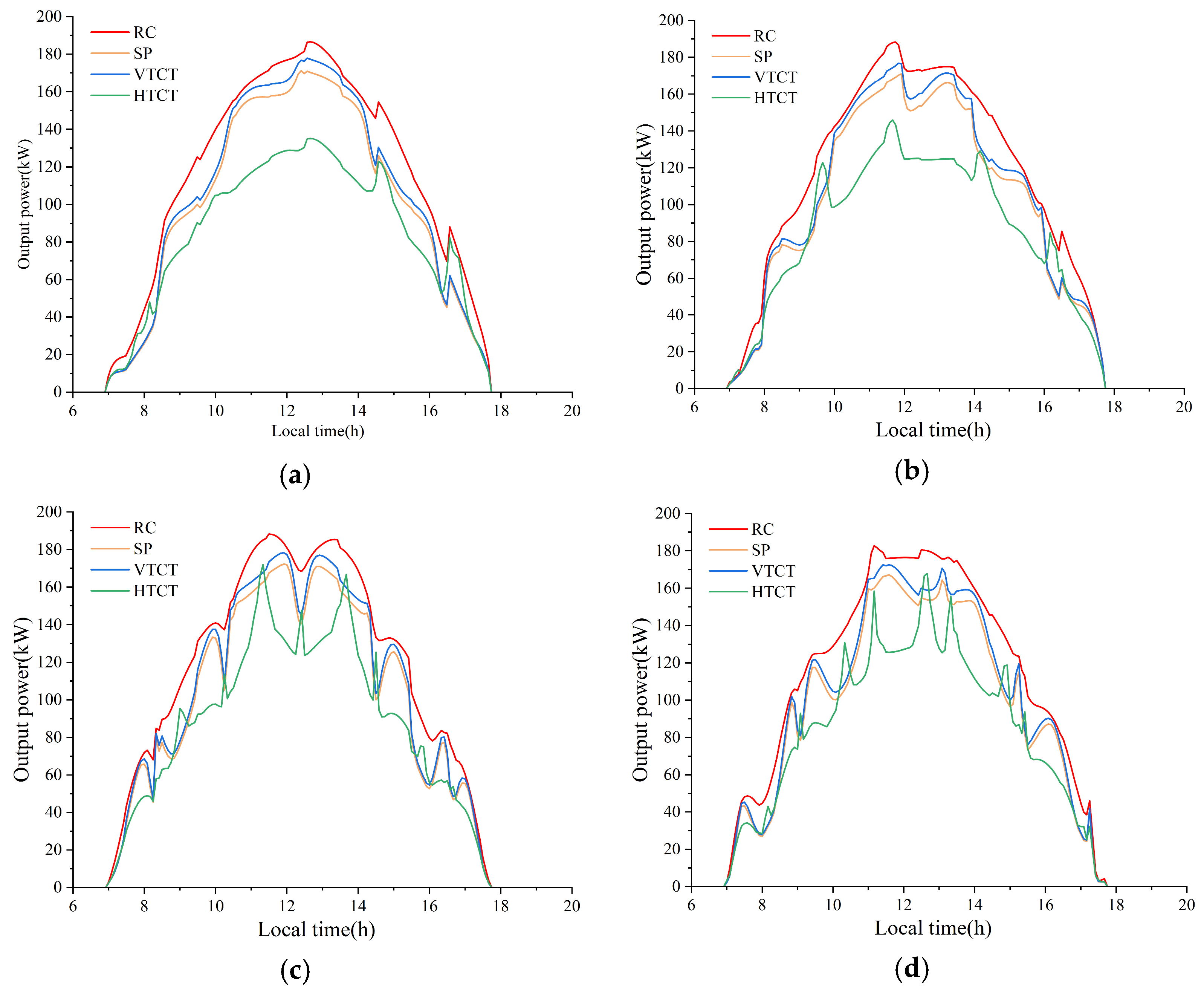
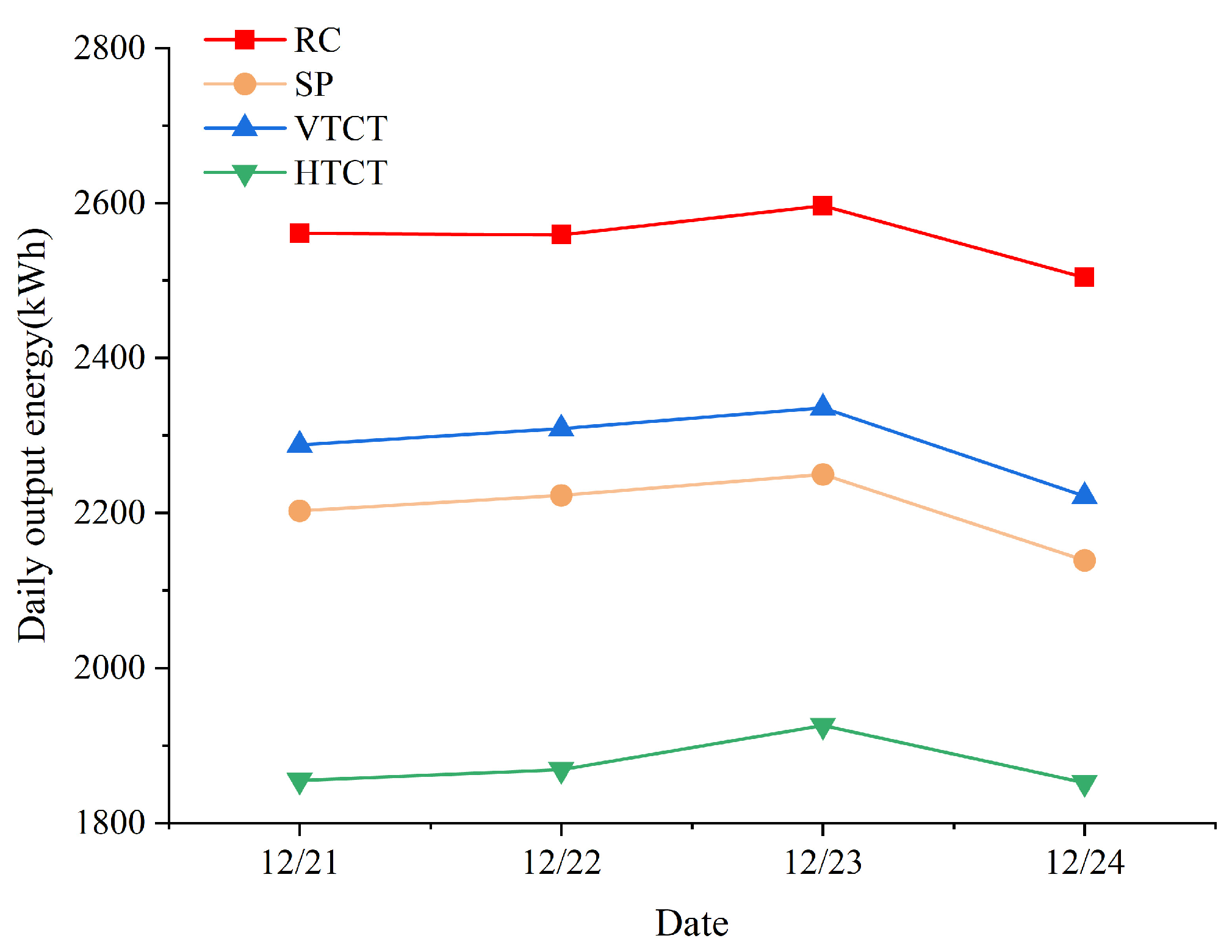
| Condition | Date | Time | Pitch Angle | Yaw Angle |
|---|---|---|---|---|
| 1 | 12.25 | 10:00 | −8 | 270 |
| 2 | 12.25 | 10:00 | 10 | 10 |
| 3 | 12.25 | 10:00 | 8 | 180 |
| 4 | 12.25 | 10:00 | −6 | 120 |
| Parameter | Value |
|---|---|
| Maximum power | 6477.6 W |
| 133.5 V | |
| 67.36 A | |
| 105.3 V | |
| 61.52 A | |
| −0.363%/°C | |
| Temperature coefficient of | −0.0843%/°C |
| 968.6 Ω | |
| 0.58 Ω |
Disclaimer/Publisher’s Note: The statements, opinions and data contained in all publications are solely those of the individual author(s) and contributor(s) and not of MDPI and/or the editor(s). MDPI and/or the editor(s) disclaim responsibility for any injury to people or property resulting from any ideas, methods, instructions or products referred to in the content. |
© 2024 by the authors. Licensee MDPI, Basel, Switzerland. This article is an open access article distributed under the terms and conditions of the Creative Commons Attribution (CC BY) license (https://creativecommons.org/licenses/by/4.0/).
Share and Cite
Shan, C.; Sun, K.; Cheng, D.; Ji, X.; Gao, J.; Zou, T. A Novel Reverse Combination Configuration to Reduce Mismatch Loss for Stratospheric Airship Photovoltaic Arrays. Appl. Sci. 2024, 14, 747. https://doi.org/10.3390/app14020747
Shan C, Sun K, Cheng D, Ji X, Gao J, Zou T. A Novel Reverse Combination Configuration to Reduce Mismatch Loss for Stratospheric Airship Photovoltaic Arrays. Applied Sciences. 2024; 14(2):747. https://doi.org/10.3390/app14020747
Chicago/Turabian StyleShan, Chuan, Kangwen Sun, Dongji Cheng, Xinzhe Ji, Jian Gao, and Tong Zou. 2024. "A Novel Reverse Combination Configuration to Reduce Mismatch Loss for Stratospheric Airship Photovoltaic Arrays" Applied Sciences 14, no. 2: 747. https://doi.org/10.3390/app14020747
APA StyleShan, C., Sun, K., Cheng, D., Ji, X., Gao, J., & Zou, T. (2024). A Novel Reverse Combination Configuration to Reduce Mismatch Loss for Stratospheric Airship Photovoltaic Arrays. Applied Sciences, 14(2), 747. https://doi.org/10.3390/app14020747







